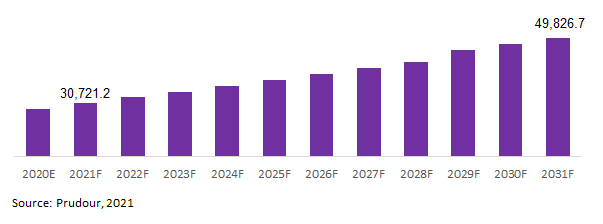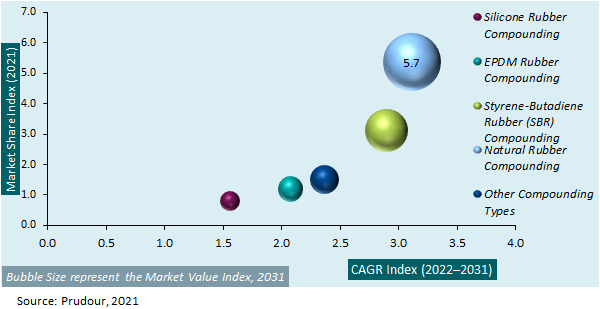Global Rubber Compound Market By Type(Silicone Rubber Compounding, Epdm Rubber Compounding, Styrene-Butadiene Rubber (Sbr) Compounding, Natural Rubber Compounding), By End-Use Industry (Footwear, Automotive, Building & Construction, Wire & Cable), By Region, and Key Companies - Industry Segment Outlook, Market Assessment, Competition Scenario, Trends and Forecast 2021-2031
- Published date: Nov 2021
- Report ID: 14778
- Number of Pages: 363
- Format:
- keyboard_arrow_up
Increase in Applications in various industries such as automotive, packaging, manufacturing, engineering, and construction For Natural Rubber, Thereby Boosting The Demand For Global Rubber Compound Market
Market.US announces the publication of its most recently generated research report titled, “Global Rubber Compound Market by Type(Silicone Rubber Compounding, EPDM Rubber Compounding, Styrene-Butadiene Rubber (SBR) Compounding, Natural Rubber Compounding, Other Compounding Types), by End-Use Industry (Footwear, Automotive, Building & Construction, Wire & Cable, Other End-Use Industries), and by Region – Global Forecast to 2031”, which offers a holistic view of the Global Rubber Compound Market through systematic segmentation that covers every aspect of the target market.
The Global Rubber Compound Market is projected to be US$ 30,721.2 Mn in 2021 to reach US$ 49,826.7 Mn by 2031 at a CAGR of 5.1%.
Rubber is made up of polymers of the chemical compound isoprene, with tiny impurities of other organic compounds. It is also known as latex, Amazonian rubber, caucho, or caoutchouc. Compounding is the process of incorporating additives, fillers, polymers, or reinforcements into a homogenous polymer mixture in order to improve characteristics and meet performance criteria.
Internal mixers are used to prepare rubber compositions, generating high shear pressures that disperse the fillers and raw materials into a uniform, high-quality compound. The compound is then thrown into a mill, extruder, or pelletizer after it has been mixed. The physical attributes of a final product, the processing characteristics necessary throughout the production process, and the acceptable economics of a finished product will all influence the ingredients chosen for a compound.
Natural rubber and synthetic rubber are the two types of rubber. The sap (latex) of the rubber tree is used to make natural rubber, whereas petroleum is used to make synthetic rubber. Both of these types influence each other’s demand; for example, if the price of petroleum rises, so does the demand for natural rubber. When natural rubber supply problems cause its price to skyrocket, the market tends to resort to synthetic rubber.
Global Rubber Compound Market Revenue (US$ Mn), 2021–2031

As the largest end-user of rubber, the automotive industry utilizes a huge amount of rubber to create pipes, automobile tyres, gaskets, hoses, and other parts. High market expansion in developing economies, as well as an increase in per capita income among consumers in these countries, is driving up demand for automobiles, which is driving up demand for rubber compounds in these areas. Because of the presence of export-oriented manufacturing organizations and increased domestic demand from numerous end-user sectors, the Asia-Pacific area is a large rubber market.
As demand from numerous industries such as construction, automotive, consumer goods, footwear, and others boosts the rubber market, it also confronts stiff competition from material manufacturers such as polymers, plastics, and vinyl. When compared to rubber, polymers and plastics are less expensive, and they are also available in large quantities all over the world.
Furthermore, polymers like ABS, PET, and PP have superior properties like elasticity, durability, anti-slip, and rigidity, making them excellent alternatives. Plastic-based items such as pipes, tubes, and seals are replacing rubber-based products in industrial and rubber applications. As a result, the availability of alternatives is projected to reduce the target market’s expansion possibilities to some amount.
Rubber compounds are used in a variety of industries, including transportation, packaging, manufacturing, engineering, and construction. It produces reliable results when mixed with various polymers and chemicals in the creation of surgical supplies, respirators, pacemakers, and feeding nipples. Many businesses in this industry specialise in compounding rubber to customer requirements in order to create new goods.
Coated rubber on a rotating or stationary drum, for example, is used to make reinforced items like drive belts, air brake diaphragms, and conveyors. Unreinforced rubber, on the other hand, is shaped and cured to resemble a sponge. As a result, new product development is likely to provide enormous potential opportunities for this industry.
A growing emphasis on market growth methods such as new product launches, mergers and acquisitions, partnerships, and increased investments in product refinements and technological innovations, among other things, is part of a broader trend in this industry. Major firms’ increased focus on research and development operations to create sustainable rubber goods is also expected to boost revenue in this market.
Global Rubber Compound Market Attractiveness Analysis by Type, 2015–2031

Segmentation of the global rubber compound market is achieved under the following – type, end-use industry, & region. On the basis of type, the market is further categorized into silicone rubber compounding, EPDM rubber compounding, Styrene-Butadiene Rubber (SBR) compounding, natural rubber compounding, and other compounding types.
Among all the type segments, the natural rubber compounding segment is expected to register the highest CAGR of over 5.7%, followed by Styrene-Butadiene Rubber (SBR) compounding. In terms of end-use industry, the market is segmented into footwear, automotive, building & construction, wire & cable, and other end-use industries.
Amongst end-use industry segments, the automotive segment in the global rubber compound market is estimated to account for a majority revenue share of 71.4% in 2021 end. The global rubber compound market is segmented region-wise into North America, Europe, Asia-Pacific, South America, and the MEA, respectively. Asia-Pacific market is expected to dominate the global rubber compound market, followed by Europe region. It is expected to account for the largest market revenue share as compared to that of markets in other regions.
The research report on the Global Rubber Compound Market includes profiles of some of the major companies such as– Exxon Mobil Corp., Continental AG, Shin-Etsu Chemical Co., Ltd. (Shin Etsu Silicone), Cooper-Standard Holdings, Inc., HEXPOL AB, AirBoss of America Corp., POLYMERTECHNIK ELBE GMBH, Jiangsu Guanlian New Material Technology Co. Ltd., Rex Hide Inc. (Dyna-Mix, Inc.), SPC Europe Group, DRI Rubber, and SSJ Rubber among others.
Global Rubber Compound Market Segmentation Based on Type, End-Use Industry, and Region
Based on Type:
- Silicone Rubber Compounding
- EPDM Rubber Compounding
- Styrene-Butadiene Rubber (SBR) Compounding
- Natural Rubber Compounding
- Other Compounding Types
Based on End-Use Industry:
- Footwear
- Automotive
- Building & Construction
- Wire & Cable
- Other End-Use Industries
Based on Regions:
- North America
- Europe
- Asia Pacific
- South America
- MEA
Based on Key Players:
- Exxon Mobil Corp.
- Continental AG
- Shin-Etsu Chemical Co. Ltd. (Shin Etsu Silicone)
- Cooper-Standard Holdings Inc.
- HEXPOL AB
- AirBoss of America Corp.
- POLYMERTECHNIK ELBE GMBH
- Jiangsu Guanlian New Material Technology Co. Ltd.
- Rex Hide Inc. (Dyna-Mix Inc.)
- SPC Europe Group
- DRI Rubber
- SSJ Rubber
- others
For the Rubber Compound Market research study, the following years have been considered to estimate the market size:
Attribute Report Details Historical Years
2016-2020
Base Year
2021
Estimated Year
2022
Short Term Projection Year
2028
Projected Year
2023
Long Term Projection Year
2032
Report Coverage
Competitive Landscape, Revenue analysis, Company Share Analysis, Manufacturers Analysis, Volume by Manufacturers, Key Segments, Key company analysis, Market Trends, Distribution Channel, Market Dynamics, COVID-19 Impact Analysis, strategy for existing players to grab maximum market share, and more.
Regional Scope
North America, Europe, Asia-Pacific, South America, Middle East & Africa
Country Scope
United States, Canada and Mexico, Germany, France, UK, Russia and Italy, China, Japan, Korea, India and Southeast Asia, Brazil, Argentina, Colombia etc.Saudi Arabia, UAE, Egypt, Nigeria and South Africa
![Rubber Compound Market Rubber Compound Market]()
- Exxon Mobil Corp.
- Continental AG
- Shin-Etsu Chemical Co. Ltd. (Shin Etsu Silicone)
- Cooper-Standard Holdings Inc.
- HEXPOL AB
- AirBoss of America Corp.
- POLYMERTECHNIK ELBE GMBH
- Jiangsu Guanlian New Material Technology Co. Ltd.
- Rex Hide Inc. (Dyna-Mix Inc.)
- SPC Europe Group
- DRI Rubber
- SSJ Rubber
- others
- settingsSettings
Our Clients
|
Single User
$5,999
$2,999
USD / per unit
save 50% |
Multi User
$7,999
$3,499
USD / per unit
save 55% |
Corporate User
$12,999
$4,499
USD / per unit
save 65% | |
|---|---|---|---|
| e-Access | |||
| Data Set (Excel) | |||
| Company Profile Library Access | |||
| Interactive Dashboard | |||
| Free Custumization | No | up to 10 hrs work | up to 30 hrs work |
| Accessibility | 1 User | 2-5 User | Unlimited |
| Analyst Support | up to 20 hrs | up to 40 hrs | up to 50 hrs |
| Benefit | Up to 20% off on next purchase | Up to 25% off on next purchase | Up to 30% off on next purchase |
| Buy Now ($ 2,999) | Buy Now ($ 3,499) | Buy Now ($ 4,499) |








